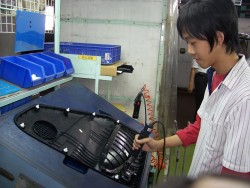Cooperation Between Industry and School Benefits All

"The Executive Yuan hopes that the per capita income will reach US$30,000 by the year 2015," said Education Minister Tu Cheng-sheng. "The Executive Yuan has designed 'five projects' for implementation from next year until 2009 under the 'three-year sprint plan,' including the human resource package, among others."
Moreover, the MOE proposed the "Employment Program for Students of Major Industry Courses in Vocational Schools," seen as the first choice of many school dropouts, will be of assistance to the poor students by training them for employment. The "Industrial Master Program" has since 2004 produced manpower in the thousands, and the "Two-Year Junior College Program" has helped fill the gaps in the industrial manpower.
The Industry and School Cooperation Program adopts the three-in-one policy of bringing together vocational schools, junior colleges, and industrial sector to work on an education system implementing the vertical continuation principle.
The industrial sector and the schools would design the curriculum together. Moreover, industrial experts would be invited to serve as teachers of technology, use facilities with flexibility and uphold the spirit of practical application. .
"The local traditional concept of education is test-oriented, which is against the poor students, but a high education diploma doesn't necessarily help a student land a good job," said Tu at various vocational education symposia.
The MOE hopes to alleviate the financial burden of poor families and help students determine the direction of their future through the Industry and School Cooperation Program.
"Society has been highly critical of the phenomenon indicating that graduation time for students means the time to start experiencing unemployment," stressed Tu. "Hence, the vocational schools as well as the universities will have to offer a practical curriculum. Training should be relevant to future employment. Universities should develop in this direction."